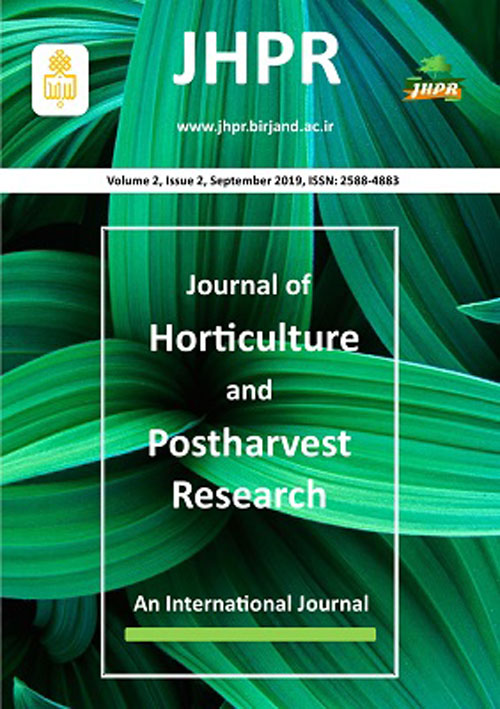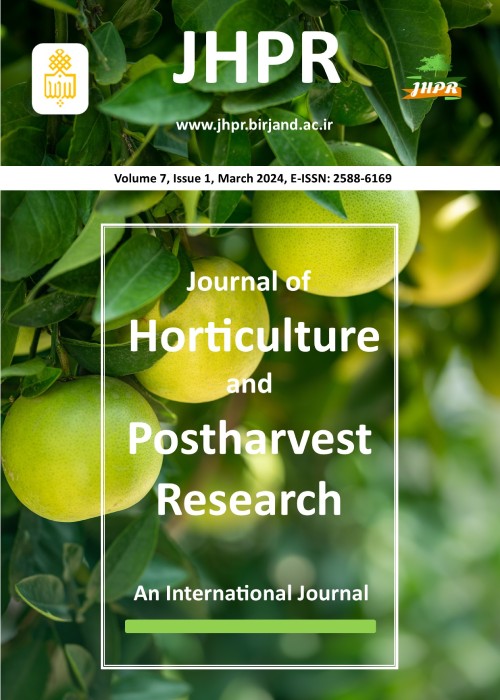فهرست مطالب

Journal of Horticulture and Postharvest Research
Volume:2 Issue: 2, Sep 2019
- تاریخ انتشار: 1398/04/13
- تعداد عناوین: 7
-
Pages 95-103PurposeCabbage is important fresh vegetable crop in most of the countries of the world. The experiment was conducted to evaluate the growth and yield of cabbage (Brassica oleracea var. capitata L. cv. Atlas-70) as influenced by organic and inorganic fertilizers, and mulching.Research methodsThe experiment comprised of two different factors such as, factor-A; four different types of fertilizers viz. F0 (control, no fertilizer), F1 (vermicompost), F2 (inorganic fertilizer), and F3 (mixed of organic and inorganic fertilizer) and factor-B; types of mulches viz. M0 (control, no mulch), M1 (water hyacinth), M2 (rice straw), M3 (black polythene). This two factors experiment was conducted in Randomized Complete Block Design (RCBD) with three replications.FindingsSignificant variation was found among the treatments. Result showed F3M3 (combination organic and inorganic fertilizer with black polythene) had the highest growth (plant height, stem length, root length, number of roots etc.) and yield (105.93 t/ha) in cabbage. The yield was 63.92% higher from the combined effect of fertilizer and mulch as black polythene (F3M3) compared to control (F0M0). So, mineral fertilizer and vermicompost with black polythene had the best performance considering the growth and yield of cabbage.Research limitationsEvaluation of different ratios of organic and inorganic fertilizers with mulching could have better outcome or findings of this work.Originality/ValueCombination of organic and inorganic fertilizers with black polythene as mulch have showed the highest growth and yield outcome of cabbage compared to other treatments combinations.This work has the opportunity to reduce the application of inorganic fertilizer to improve the soil health and environment in long run.Keywords: Cabbage, Fertilizer, Mulch, Production, Vermicompost
-
Pages 105-116PurposeSwiss chard (Beta vulgaris L.) is highly appreciated for its nutritional properties, year round availability, low cost and wide use. In central highlands of Ethiopia, Swiss chard has been producing in urban and peri-urban areas but limited information is available about its nutrition and planting distance.Research methodAn experiment was designed to study the effects of 50, 100 and 150 kg ha-1 and control (0 kg ha-1), and different spacing with row including 20 cm, 30 cm and 40 cm distance on growth, yield and nutritional composition of Swiss chard in Debre Berhan. Treatments were set in randomized complete block design with three replications making 45 treatment combinations.FindingsResults indicated that total plant fresh weight, total plant dry weight, above ground fresh weight, above ground dry weight, root fresh weight, root dry weight, plant height, leaf number per plant were significantly affect by the interaction effect of plant spacing and N levels. Leaf area index was significantly affected by intra-row spacing but not by N rate and their interaction. Remarkable difference was recorded on total nitrogen, nitrate contents and vitamin C of leaves due to varied N levels. Generally, growth attributes, yield performance and nutritional composition of Swiss chard obtained best at the combination of 100 kg N ha-1 N and 40 cm plant spacing.Research limitationIntra-Row needs further study above the 40 cm planting distance.Originality/Valuecombination of 100 kg N ha-1 and 40 cm in-row spacing can be used for Swiss chard production in Debre Berhan central highlands of Ethiopia.Keywords: Dry weight, Fresh weight, Leaf yield, Nitrate content, Vitamin C
-
Pages 117-130PurposeTomato postharvest losses are as high as 60% in Nigeria despite being 13th producer. This could be reduced when tomatoes were carefully treated and packaged. This research investigated the effects of chemical dips and packaging on storability of tomatoes.Research methodThe research was a factorial design laid out in RCBD with three replications. The field work was done in Kura while the laboratory was done at Kano University of Science and Technology. Tomatoes were harvested, sorted, weighed into 3 kg lots and treated (D1= dip in water, D2= dip in 200 ppm NaOCl and 1% CaCl2 for 5 minutes and D3= dip in 200 ppm NaOCl and 3% C6H7KO2 for 5 and 1 minutes respectively) and packaged as follows: (P1= kraft paper, P2= perforated polyethylene and P3= sealed polyethylene). Analyses of firmness, % weight loss, % rot, ascorbic acid and lycopene were carried out every 3 days. Data collected were analyzed using GLM procedure (SAS) and means separated using LSD. MainfindingsResults showed fruits dipped in 200 ppm NaOCl and CaCl2 for 5 minutes; packaged in perforated PE; and fruits dipped in 200 ppm NaOCl and CaCl2 for 5 minutes and packaged in sealed polyethylene were the best combinations. The treatments maintained physico-chemical parameters of tomatoes within acceptable limit for 24 days.LimitationsFirmness measurement was a challenge of the study.Originality/ValueA combination of the two factors is novel in the study environment and this could help in reducing the postharvest losses thereby improving farmers’ income.Keywords: postharvest, Dips, Polyethylene, Storability, Tomato
-
Pages 131-141PurposeQuality loss is high in pomegranate due to physiological disorders occurred during growth and developmental stages of fruit in main production areas in Iran.Research methodwe evaluated the effects of preharvest fruit bagging time (July and August), and bag color (white and brown) on sunburn, cracking, anthocyanin content, and quality of pomegranate fruit. This experiment was carried out on eight-year-old pomegranate trees cv. Shishe-Kab in an orchard located in Ferdows, South Khorasan province, Iran.Main findingsThe results showed that the maximum (90%) and minimum (25%) sunburn percentage was observed in control (non-bagged fruits) and white-bagged fruits at August (WBA), respectively. Similarly, the highest percentage of cracking (65%) and the lowest (5%) was obtained in control and WBA, respectively. Non-bagged fruits showed the highest (23.61 mg-1) anthocyanin, and the lowest rate (13.55 mg-1) observed in brown-bagged fruit in July (BBJ). The brightness (L) of the peel color of brown-bagged fruit in August (BBA) was the highest while the lowest L value obtained in control and white-bagged fruits in July (WBJ). Bagging did not change the weight, volume, and pH of pomegranate juice. Interestingly, bagging in both white and brown bag effectively reduced fruit sunburn and cracking and decreased the total damaged fruits, particularly when fruits were bagged in August, as compared with non-bagged control.Research limitationsNo limitations were founded.Originality/ValueThe results suggest that proper pre-harvest bagging to improve the quality and reduce losses of pomegranate fruit cv. Shishe-Kab.Keywords: Anthocyanin, Hue, postharvest, Punica granatum
-
Pages 143-155PurposePeach is a climacteric fruit which have rapid ripening. An alternative to maintain quality and extend the shelf life of this fruit could be the use of edible coatings.Research MethodIn the present study, the effect of three different coatings; 0.5% chitosan, 200 mg L-1 thymol essential oil and their combined use on postharvest quality of peach fruits cv. ‘Zaferani’ were investigated. Dipping fruits in distilled water was used as a control. Changes in weight loss, fruit firmness, total soluble solids (TSS), sensory attributes, decay incidence, anthocyanin and carotenoid content of fruits were evaluated after 10, 15, 20, 25 and 30 days of storage at 6 °C.FindingsThe results showed that the combination treatment of chitosan and thymol presented more effective preservative effect than chitosan or thymol coatings alone. The coated fruits with 0.5% chitosan + 200 mg L-1 thymol showed significantly lower weight loss, fungal decay and TSS than control treatment. Furthermore, the coated fruits with 0.5% chitosan + 200 mg L-1 thymol exhibited significantly higher firmness, anthocyanin and carotenoid content and sensory characteristics than untreated control. In addition, the highest shelf life (28.33 days) was recorded in combination treatment of chitosan and thymol.Research limitationsNo limitations were founded.Originality/ValueThe coating composed of chitosan and thymol essential oil can provide an efficient alternative for quality maintenance and shelf life extension of peach fruits.Keywords: edible coating, panel test, shelf life, postharvest
-
Effect of pre-treatments and drying methods on the quality attributes of dehydrated pineapple slicesPages 157-165PurposePineapple fruit is a rich source of minerals and vitamins. Its shelf life is very short due to perishability characteristic.Research MethodIn this research, the effect of pre-treatments on pineapple slices for its preservation and acceptability was studied. The pineapple slices were treated with three different osmotic (table sugar) solution concentrations, temperature, and vacuum pressure levels to find the most suitable treatment in term of quality. Different parameters such as weight reduction, water loss, solid gain, nutritional quality and sensory test (texture, taste, odor, and appearance) were studied. To perform these parameters pineapple slices were immersed in sugar solution on 50, 60 ºB (degree Brix) at 30, 40 and 50 ºC followed by three vacuum pressures including 435 mmHg, 110 mmHg and atmospheric 760 mmHg pressures for up to 180 min.FindingsResults showed that water loss in pineapple slices increased with increase in vacuum level in all three sugar concentrations and degrees of temperatures in osmotic solution. Weight reduction, water loss, solid gain, water activity, total color, ascorbic acid content, whereas sugar content was found significantly affecting the process followed by temperature and levels of vacuum.Research limitationsThere were no limitations to report.Originality/ValueIt was found that the most affecting treatment was vacuum pressure, whereas the highest changes occurred in appearance followed by the ascorbic acid content of the samples treated with different parameters.Keywords: Osmotic dehydration, Sugar concentration, Vacuum drying
-
Pages 167-176PurposeSaffron (Crocus sativus L.) is a valuable medicinal plant with a short flowering period. Its flowering management can be useful for the production of saffron in a farm or controlled condition. The objective of this study was to determine the effect of plant growth regulators (PGRs) on saffron corms sprouting.Research methodFor this purpose, corms were treated with different PGRs including α-naphthaleneacetic acid (NAA) (0, 100, 200, 300 ppm), chlorocholine chloride (CCC) (0, 100, 200, 300 ppm) and gibberellic acid (GA3) (0, 5, 10, 20 ppm) for two hours and incubated at 20-22 °C for eight weeks.FindingsThe results revealed that the effect of PGRs on corms sprouting was significant. It has been shown that treatment of corms with auxin at all concentrations reduced sprouting compared to the control. To prolong dormancy for five weeks, NAA at 200 mg L-1 was the best choice. While for the fifth week onwards, the most effective treatment was NAA at 100 ppm. Treatment with GA3 (20 ppm) has shown a stimulatory effect on corm sprouting.Research limitationsNo limitations were founded.Originality/ValueSprouting acceleration can keep flowering away from early autumn frosting in farm conditions, while prolongation of corms dormancy provides the possibility of harvesting saffron flowers in several times in a hydroponic system. The results of this study suggested two kinds of chemical for different purposes, inhibition and stimulation of sprouting of saffron corms that can be applicable for saffron hydroponic or farm production, respectively.Keywords: CCC, Corm sprouting, Crocus sativus, GA3, NAA


